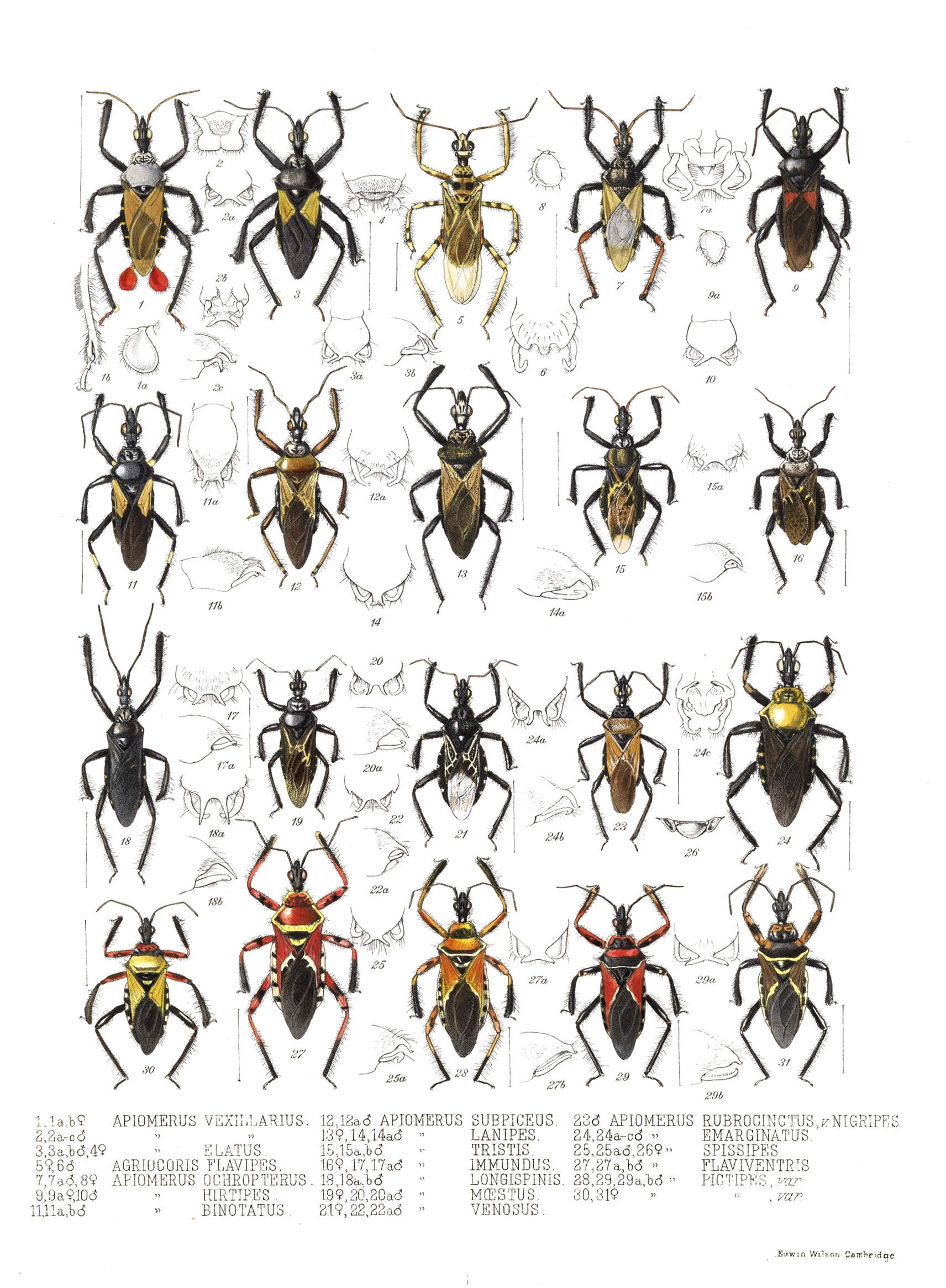Apiomerus on:
[Wikipedia]
[Google]
[Amazon]
''Apiomerus'' is a genus of conspicuous, brightly colored assassin bugs belonging to the family  Species in the genus include:
*'' Apiomerus californicus'' Berniker & Szerlip, 2011
*'' Apiomerus cazieri'' Berniker & Szerlip, 2011
*'' Apiomerus cooremani'' Costa Lima, Campos Seabra & Hathaway, 1951
*'' Apiomerus crassipes'' (Fabricius, 1803)
*'' Apiomerus flaviventris'' Herrich-Schaeffer, 1846
*'' Apiomerus floridensis'' Berniker & Szerlip, 2011
*'' Apiomerus hirtipes'' (Fabricius, 1787)
*'' Apiomerus immundus'' Bergroth, 1898
*'' Apiomerus longispinis'' Champion, 1899
*'' Apiomerus moestus'' Stål, 1862
*'' Apiomerus montanus'' Berniker & Szerlip, 2011
*'' Apiomerus peninsularis'' Berniker & Szerlip, 2011
*'' Apiomerus pictipes'' Herrich-Schaeffer, 1846
*'' Apiomerus pilipes'' Fabricius, 1787
*'' Apiomerus repletus'' Uhler, 1876
*'' Apiomerus rufipennis'' (Fallou, 1889)
*'' Apiomerus spissipes'' (Say, 1825)
*'' Apiomerus subpiceus'' Stål, 1862
*'' Apiomerus wygodzinskyi'' Berniker & Szerlip, 2011
Species in the genus include:
*'' Apiomerus californicus'' Berniker & Szerlip, 2011
*'' Apiomerus cazieri'' Berniker & Szerlip, 2011
*'' Apiomerus cooremani'' Costa Lima, Campos Seabra & Hathaway, 1951
*'' Apiomerus crassipes'' (Fabricius, 1803)
*'' Apiomerus flaviventris'' Herrich-Schaeffer, 1846
*'' Apiomerus floridensis'' Berniker & Szerlip, 2011
*'' Apiomerus hirtipes'' (Fabricius, 1787)
*'' Apiomerus immundus'' Bergroth, 1898
*'' Apiomerus longispinis'' Champion, 1899
*'' Apiomerus moestus'' Stål, 1862
*'' Apiomerus montanus'' Berniker & Szerlip, 2011
*'' Apiomerus peninsularis'' Berniker & Szerlip, 2011
*'' Apiomerus pictipes'' Herrich-Schaeffer, 1846
*'' Apiomerus pilipes'' Fabricius, 1787
*'' Apiomerus repletus'' Uhler, 1876
*'' Apiomerus rufipennis'' (Fallou, 1889)
*'' Apiomerus spissipes'' (Say, 1825)
*'' Apiomerus subpiceus'' Stål, 1862
*'' Apiomerus wygodzinskyi'' Berniker & Szerlip, 2011
Bugguide hosted by Iowa State University Entomology
Research of ''Apiomerus'' Systematics at UC Riverside
*https://web.archive.org/web/20110726225254/http://nature.berkeley.edu/~dchoe003/index4.htm Reduviidae Cimicomorpha genera Insects of Central America {{Cimicomorpha-stub
Reduviidae
The Reduviidae are a large cosmopolitan family of the order Hemiptera (true bugs). Among the Hemiptera and together with the Nabidae almost all species are terrestrial ambush predators: most other predatory Hemiptera are aquatic. The main exampl ...
. The species can be found in the United States
The United States of America (U.S.A. or USA), commonly known as the United States (U.S. or US) or America, is a country primarily located in North America. It consists of 50 states, a federal district, five major unincorporated territorie ...
ranging into tropical America
The United States of America (U.S.A. or USA), commonly known as the United States (U.S. or US) or America, is a country primarily located in North America. It consists of 50 states, a federal district, five major unincorporated territorie ...
. The common name bee assassins derives from their frequent habit of sitting and waiting upon flowers and taking bee
Bees are winged insects closely related to wasps and ants, known for their roles in pollination and, in the case of the best-known bee species, the western honey bee, for producing honey. Bees are a monophyly, monophyletic lineage within the ...
s as prey. The bright colors are aposematic
Aposematism is the advertising by an animal to potential predators that it is not worth attacking or eating. This unprofitability may consist of any defences which make the prey difficult to kill and eat, such as toxicity, venom, foul taste or ...
, likely a warning to larger predators that a painful bite can be delivered.
Many species of this genus have a sticky resin pad located on their dorsal abdomen. The resin is thought to be derived from plant material and may play a role in defending eggs from predation, especially by ants.
The genus consists of about 110 described species.Schuh and Slater 1995
 Species in the genus include:
*'' Apiomerus californicus'' Berniker & Szerlip, 2011
*'' Apiomerus cazieri'' Berniker & Szerlip, 2011
*'' Apiomerus cooremani'' Costa Lima, Campos Seabra & Hathaway, 1951
*'' Apiomerus crassipes'' (Fabricius, 1803)
*'' Apiomerus flaviventris'' Herrich-Schaeffer, 1846
*'' Apiomerus floridensis'' Berniker & Szerlip, 2011
*'' Apiomerus hirtipes'' (Fabricius, 1787)
*'' Apiomerus immundus'' Bergroth, 1898
*'' Apiomerus longispinis'' Champion, 1899
*'' Apiomerus moestus'' Stål, 1862
*'' Apiomerus montanus'' Berniker & Szerlip, 2011
*'' Apiomerus peninsularis'' Berniker & Szerlip, 2011
*'' Apiomerus pictipes'' Herrich-Schaeffer, 1846
*'' Apiomerus pilipes'' Fabricius, 1787
*'' Apiomerus repletus'' Uhler, 1876
*'' Apiomerus rufipennis'' (Fallou, 1889)
*'' Apiomerus spissipes'' (Say, 1825)
*'' Apiomerus subpiceus'' Stål, 1862
*'' Apiomerus wygodzinskyi'' Berniker & Szerlip, 2011
Species in the genus include:
*'' Apiomerus californicus'' Berniker & Szerlip, 2011
*'' Apiomerus cazieri'' Berniker & Szerlip, 2011
*'' Apiomerus cooremani'' Costa Lima, Campos Seabra & Hathaway, 1951
*'' Apiomerus crassipes'' (Fabricius, 1803)
*'' Apiomerus flaviventris'' Herrich-Schaeffer, 1846
*'' Apiomerus floridensis'' Berniker & Szerlip, 2011
*'' Apiomerus hirtipes'' (Fabricius, 1787)
*'' Apiomerus immundus'' Bergroth, 1898
*'' Apiomerus longispinis'' Champion, 1899
*'' Apiomerus moestus'' Stål, 1862
*'' Apiomerus montanus'' Berniker & Szerlip, 2011
*'' Apiomerus peninsularis'' Berniker & Szerlip, 2011
*'' Apiomerus pictipes'' Herrich-Schaeffer, 1846
*'' Apiomerus pilipes'' Fabricius, 1787
*'' Apiomerus repletus'' Uhler, 1876
*'' Apiomerus rufipennis'' (Fallou, 1889)
*'' Apiomerus spissipes'' (Say, 1825)
*'' Apiomerus subpiceus'' Stål, 1862
*'' Apiomerus wygodzinskyi'' Berniker & Szerlip, 2011
References
*Schuh, R.T. & Slater, J. A. 1995. True bugs of the world (Hemiptera: Heteroptera): classification and natural history. New York, Cornell University Press, 336p.External links
Bugguide hosted by Iowa State University Entomology
Research of ''Apiomerus'' Systematics at UC Riverside
*https://web.archive.org/web/20110726225254/http://nature.berkeley.edu/~dchoe003/index4.htm Reduviidae Cimicomorpha genera Insects of Central America {{Cimicomorpha-stub